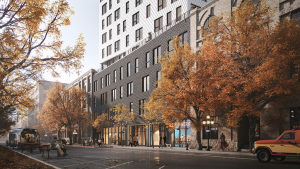The Canada Summer Games will celebrate 50 years in 2017 with a lasting impact on its host city, Winnipeg, Man.
Legacy builds for the two-week-long event include a permanent mountain-bike course at FortWhyte Alive, new beach volleyball courts in the Cindy Klassen Recreation Complex and a $24-million addition to the city’s Sport for Life Centre.
Adding a brand new build to a century-old warehouse in downtown Winnipeg to expand the Sport for Life Centre is by far the biggest project and greatest challenge, says Jeff Hnatiuk, president and CEO of the 2017 Canada Games Host Society.
Sport Manitoba developed the first phase of the centre in 2010 by renovating an 84,000-square-foot warehouse in the city’s Exchange District, a national historic site.
The building houses offices for Manitoba’s 65 provincial sport governing bodies as well as the Manitoba Sports Hall of Fame, the Sport Medicine Centre and the Paul Robson Centre for Leadership and Coaching.
The addition, the Qualico Training Centre, will offer three storeys of sport and fitness space and ground level parking.
Among the new build’s features: a full gym on the second floor; training space for the provincial team athletes on floor three; and, on the top floor, a 525-foot-long indoor track and more training space.
Sport Manitoba owns and will operate the entire facility.
Recognition of the need for recreational space in Winnipeg’s inner city motivated the location choice for the centre, says Hnatiuk, who is also president and CEO of Sport Manitoba.
The top and second floors were designed for public use, says Doug Hanna, principal partner of Number Ten Architectural Group, the project’s prime consultant, architect and interior designer. He points to building elements that foster community engagement in other ways as well.
Low windows in the second-floor gym, for example, add daylight to the interior and provide street-level views of activities. As well, the gym divides into several smaller courts to accommodate activities such as basketball, volleyball and badminton.
The historic, densely populated inner-city neighbourhood complicates development.
To facilitate the expansion Sport Manitoba bought another nearby property and also negotiated with the city to buy a portion of a dead-end street.
At the urging of the city’s historical buildings committee, the architects ensured the warehouse remained the facility’s primary focus, even though the addition is larger.
To this end, the new build’s horizontal elements align with the horizontal elements of the warehouse to create a sympathetic relationship, says Hanna.
Tyndall stone lines the base of the warehouse exterior and will also line the base of the addition exterior. Above, the stone on the addition builders will apply corten steel-coloured metal panels to complement the brown brick on the main building.
A recessed wall both joins and separates the components "so it doesn’t look like it’s one crashing into the other," Hanna adds.
The 124,000-square-foot addition presented some engineering challenges as well.
"We have a long span space over the length of the gymnasium, so we have large long-span trusses spanning the roof," Hanna says. "A lot of attention had to be paid to how the whole track could be constructed and supported appropriately."
The timeline is tight. The addition broke ground in October and must be substantially complete by mid-May.
Winnipeg-based Bockstael Construction is the project’s general contractor. Structural engineers are Crosier, Kilgour & Partners; Tower Engineering Group is the mechanical/electrical engineer. Both firms are based in Winnipeg, as is HTFC Planning and Design, the landscape architects. MMM Group Limited is the civil engineer.
Hanna says the point at which Sport Manitoba was able to buy land and finalize agreements, such as finalizing the closure of the street portion, "pushed the schedule to its limit."
To speed construction they have used pre-finished materials, such as pre-refinished steel sandwich panels and pre-finished floors.
By late November, the building was about two weeks from being completely closed in.
The timeline isn’t the only constraint on the project.
Space is a premium in the densely packed Exchange District. The developers have had to close sidewalks to create lay-down space and establish room for a crane.
The city is also upgrading streets in the neighbourhood, including sidewalks.
"That’s creating challenges for site access even for delivery of materials," Hanna says.
The existing building is occupied, so it’s crucial to ensure good communication about construction activities with both building occupants and neighbours.
And then there are the surprises a historic area always seems to offer.
Below grade, the developers discovered a major Manitoba Telephone Services communications duct that serves most of the downtown and couldn’t be moved. Its presence affected decisions on where to locate parking.
Outside of the building footprint lay a major aqueduct in the city’s water system, which was something they did know in advance. A study was conducted to ensure the load from the crane wouldn’t negatively affect the aqueduct, Hanna says.
The addition’s components create an energy-efficient building envelope and follow the premise of LEED construction, but certification won’t be sought.
"There’s a cost to get to that level," Hanna says, and everyone realized meeting the space needs for the facility had to take priority. "Space was key to them being able to support the programs that they had and they wanted to invest the dollars wisely into what they felt they were getting the most out of in terms of their program. So we balanced all of those things."
The addition gets its first test run in June, well before the games begin.
Canada Games requires new venues to hold a test event to ensure everything works as anticipated, explains Hnatiuk.
The games run July 28 to August 13 and include competitions in 16 sports.





Recent Comments
comments for this post are closed